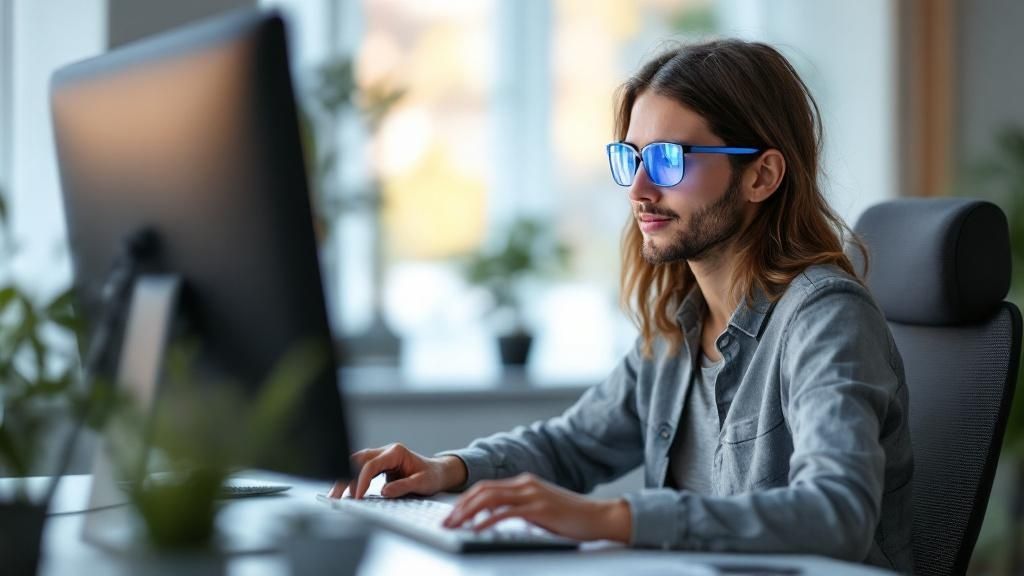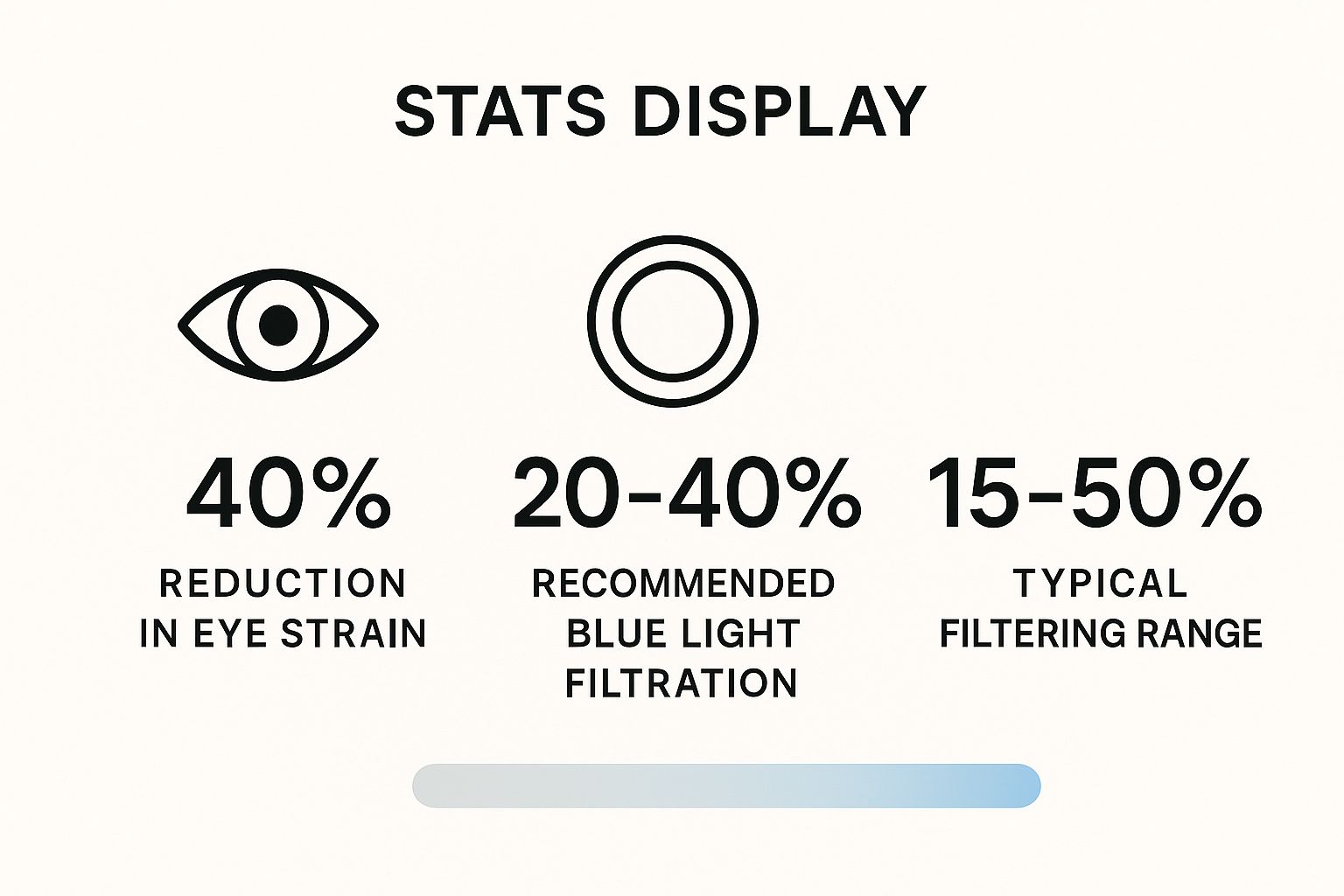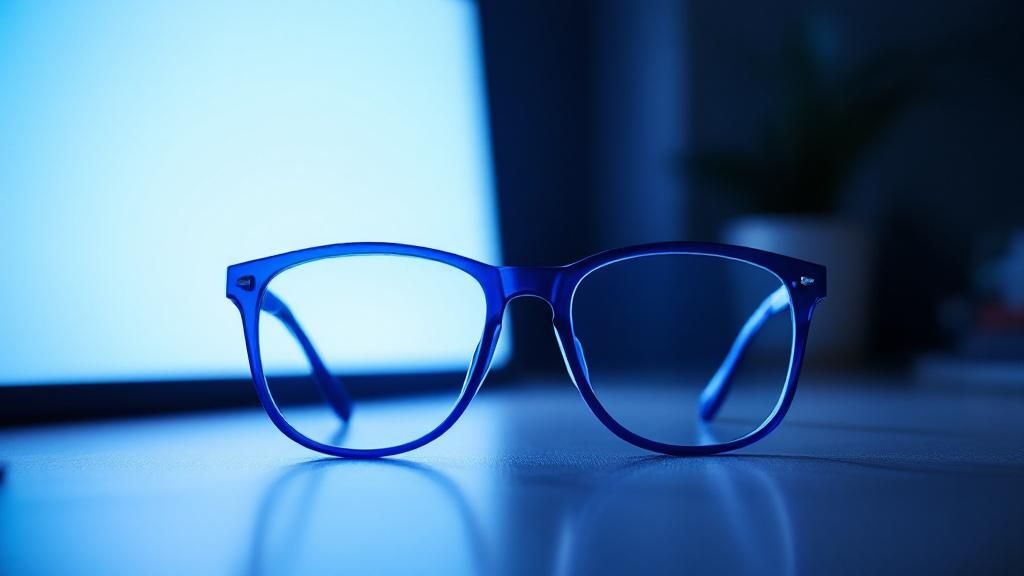
6 Key Blue Light Glasses Benefits You Need to Know in 2025
In a world dominated by screens, digital eye strain, poor sleep, and persistent headaches have become the new normal for many. But what if a simple solution could significantly improve your daily well-being? Blue light blocking glasses have emerged as a powerful tool for mitigating the negative effects of our digital-first lifestyle, and their popularity is backed by growing evidence. This article dives deep into the science-supported blue light glasses benefits, moving beyond a simple list to provide a comprehensive roundup of how this technology works.
We'll explore the tangible impacts on your health, from reducing digital eye strain and preventing headaches to dramatically improving your sleep quality. You will learn practical strategies to integrate these glasses into your routine for maximum effect, whether you're aiming for enhanced focus during the workday or better long-term eye health protection. We will also highlight how innovative brands are refining this technology for optimal visual wellness. Get ready to understand exactly how filtering blue light can help you see your screen time in a healthier new light.
1. Reduced Digital Eye Strain
If you spend hours in front of a computer, tablet, or smartphone, you’re likely familiar with the nagging discomfort of digital eye strain. This condition, also known as Computer Vision Syndrome (CVS), encompasses a range of symptoms from dry, itchy eyes and blurred vision to headaches and neck pain. A primary contributor is the high-energy visible (HEV) blue light that emanates from our screens.

One of the most significant blue light glasses benefits is their ability to directly combat this strain. By filtering a percentage of the blue light before it reaches your eyes, these specialized lenses reduce the workload on your ciliary muscles. These muscles are responsible for focusing, and they work overtime to process the harsh, high-frequency light from screens, leading to fatigue. By softening this light, the glasses help your eyes relax, making prolonged screen time significantly more comfortable.
Practical Impact on Daily Life
The effects are not just theoretical; they are tangible for people in various screen-heavy roles. For instance, office workers who have integrated blue light glasses into their workday have reported significant reductions in eye fatigue and headaches. Similarly, gamers using brands like Gunnar Optiks, which are specifically designed for high-contrast digital environments, can engage in longer sessions with less visual discomfort. Students attending online classes have also noted improved comfort, making it easier to stay focused during lectures and study sessions.
How to Maximize the Benefits
To get the most out of your glasses, consider these actionable strategies:
- Choose the Right Filtration Level: For general daytime use, lenses that filter between 20-40% of blue light are ideal. Brands like Felix Gray and Warby Parker offer stylish options in this range.
- Follow the 20-20-20 Rule: This is a crucial habit. Every 20 minutes, look at something 20 feet away for at least 20 seconds. This simple practice gives your eye muscles a much-needed break.
- Create an Ergonomic Workspace: Your glasses are just one piece of the puzzle. While blue light glasses offer specific protection, incorporating essential ergonomic desk accessories can further mitigate digital eye strain and discomfort. Proper monitor height, distance, and lighting are critical for a holistic approach to eye health.
- Consider a Computer Prescription: If you already wear corrective lenses, ask your optometrist about glasses with a computer-specific prescription that also includes a blue light filter. This ensures you’re correcting your vision and protecting it simultaneously.
2. Improved Sleep Quality
In our modern, always-on world, using digital devices before bed has become a common ritual. However, the artificial blue light from these screens can significantly disrupt our body's internal clock, or circadian rhythm. This light signals to your brain that it's still daytime, suppressing the production of melatonin, the crucial hormone that tells your body it's time to sleep. The result is often difficulty falling asleep, restless nights, and grogginess the next morning.

One of the most profound blue light glasses benefits is their ability to preserve your natural sleep-wake cycle. By wearing glasses that filter blue light for 2-3 hours before bedtime, you prevent this disruptive signal from reaching your eyes. This allows melatonin production to proceed naturally, helping you feel sleepy at the appropriate time and improving the overall quality of your rest. This simple intervention can lead to falling asleep faster and experiencing deeper, more restorative sleep.
Practical Impact on Daily Life
The positive effects on sleep are well-documented across different lifestyles. For example, a study involving night-shift nurses found a remarkable 23% improvement in their sleep quality scores when they used blue-light-blocking glasses. Teenagers, who often do homework on screens late into the evening, have also shown better sleep patterns and reduced daytime sleepiness. Even frequent travelers have reported a 30% reduction in jet lag symptoms by using the glasses to help reset their body clocks to a new time zone more effectively.
How to Maximize the Benefits
To harness the sleep-enhancing power of your glasses, follow these specific strategies:
- Choose Amber or Red Lenses for Night: For evening use, opt for glasses with amber or red-tinted lenses that block a higher percentage (often 90% or more) of blue light. Brands like Swanwick Sleep and Ra Optics specialize in these more potent nighttime lenses.
- Time Your Usage: Put your blue light glasses on 2-3 hours before your intended bedtime and keep them on until you turn off the lights to sleep. Consistency is key to regulating your melatonin levels.
- Create a Sleep-Friendly Environment: Combine your glasses with other good habits. Dim your ambient lighting and enable "night mode" on your devices. While blue light glasses are a powerful tool, it's also important to get enough daylight exposure. Exploring the health benefits of natural light from skylights can help you understand how to better anchor your circadian rhythm during the day.
- Complement with Software: Use blue light filtering apps like f.lux on your computer or the built-in "Night Shift" or "Eye Comfort Shield" features on your phone as an additional layer of protection. For a deeper dive into the science, you can learn more about how blue light glasses aid sleep.
3. Headache and Migraine Prevention
For many people, the end of a long workday in front of a screen is marked by a persistent, throbbing headache or even a full-blown migraine. This isn't a coincidence. The intense, high-frequency blue light emitted by digital devices is a known trigger for photophobia (light sensitivity), a common symptom and catalyst for both tension headaches and migraines in susceptible individuals.

A key blue light glasses benefits is their potential to act as a preventative measure against these painful episodes. By filtering out the most problematic wavelengths of light, these glasses reduce the overstimulation of light-sensitive retinal cells. This lessens the neurological stress that can lead to headaches. Specialized tints, such as the FL-41 lens developed by experts like Dr. Bradley Katz, are specifically engineered to block the precise blue-green light spectrum most associated with triggering migraines, offering targeted relief.
Practical Impact on Daily Life
The real-world evidence for this benefit is compelling. Graphic designers and data analysts, who scrutinize detailed screens for hours, have reported significant reductions in afternoon headache frequency after adopting blue light glasses. Chronic migraine sufferers have found that wearing brands like Theraspecs or Axon Optics, which utilize this specialized filtering technology, helps decrease the triggering effect of office lighting and computer screens, reducing the overall number of migraine days.
How to Maximize the Benefits
To effectively use blue light glasses for headache prevention, consider these targeted strategies:
- Start with Lighter Tints: Begin with glasses that have a lighter filtration level for daytime use. If you find headaches persist, you can gradually move to a stronger, more amber-tinted lens designed for higher sensitivity.
- Track Your Headaches: Keep a simple log of when your headaches occur. This can help you identify if screen time is a primary trigger and determine the most effective times to wear your glasses, such as during intense work periods or in brightly lit environments.
- Address Physical Triggers: While blue light glasses can help mitigate visually-induced headaches, it's also crucial to consider optimizing your desk and computer chair setup, as poor ergonomics can contribute to headaches and discomfort from prolonged computer use.
- Stay Hydrated and Take Breaks: Dehydration and muscle tension are common headache contributors. Pair the use of your glasses with consistent water intake and regular breaks away from your screen. You can find more tips on how to get rid of a headache without painkillers for a holistic approach.
4. Enhanced Focus and Productivity
In today's digital-first world, maintaining concentration for extended periods is a significant challenge. The mental fog that creeps in after hours of screen time is often a direct result of visual fatigue. When your eyes are strained and tired from processing harsh blue light, your brain has to work harder to interpret visual information, draining cognitive resources that could otherwise be used for focus and critical thinking.
A key blue light glasses benefit is their ability to enhance focus by minimizing this underlying cause of mental fatigue. By filtering the disruptive wavelengths of blue light, these glasses reduce the visual noise and discomfort your eyes experience. This allows your brain to allocate more energy to high-concentration tasks, leading to improved productivity and sustained attention without the typical mid-afternoon burnout associated with heavy screen use.
Practical Impact on Daily Life
The link between visual comfort and cognitive performance is clear across many professions. Software developers, for example, report being able to code for longer stretches without losing their train of thought. Financial analysts who spend their days scrutinizing spreadsheets find they can maintain higher levels of accuracy and attention to detail. This benefit also extends to students, who often experience improved concentration during long online lectures and late-night study sessions, making it easier to absorb and retain information.
How to Maximize the Benefits
To effectively use blue light glasses for better focus, integrate them with other productivity habits:
- Time Your Usage: Wear your glasses specifically during tasks that demand your highest level of concentration, such as writing, coding, or detailed data analysis.
- Choose Professional Frames: If you work in a corporate environment, opt for stylish, professional frames from brands like Pixel Eyewear to maintain credibility while protecting your eyes.
- Combine with an Organized Workspace: Your glasses work best as part of a holistic approach. A clutter-free desk is crucial for a clutter-free mind. Maintaining an organized workspace can amplify the focus-enhancing effects of your glasses. Explore tips for a clutter-free and more productive desk setup to create an optimal environment.
- Track Your Performance: Pay attention to your own productivity metrics. Note your ability to concentrate on days you wear the glasses versus days you don't. This personal data can help you see the tangible impact on your work.
5. Reduced Glare and Visual Discomfort
Beyond filtering specific light waves, a major function of quality blue light glasses is to combat visual noise from glare and reflections. Whether you're working under harsh office lights, staring at a glossy screen, or driving at night, glare can cause you to squint, leading to headaches, facial tension, and overall visual discomfort. The best blue light glasses are equipped with anti-reflective (AR) coatings to minimize this effect.

This technology works by neutralizing reflections from both the front and back surfaces of the lenses. By allowing more light to pass through the lens directly to your eye, an AR coating provides a clearer, crisper, and more comfortable visual experience. This reduction in glare is one of the most immediate blue light glasses benefits you'll notice, creating a calmer visual field and allowing your eyes to relax instead of constantly fighting distracting reflections.
Practical Impact on Daily Life
The improvement is noticeable across many environments. Office workers often find that glasses with AR coatings, such as those with Crizal or Zeiss DuraVision technology, make the persistent hum of overhead fluorescent lights far less irritating. Retail employees exposed to bright, focused store lighting for hours can experience a significant drop in eye fatigue. Even drivers benefit, as the anti-glare properties can reduce the blinding effect of oncoming headlights during night driving, making the experience safer and less stressful.
How to Maximize the Benefits
To ensure you get the best anti-glare performance from your eyewear, follow these tips:
- Prioritize a High-Quality AR Coating: Not all coatings are equal. Look for premium options from established names like Essilor, Crizal, or Zeiss, as they offer superior durability and reflection-cancellation.
- Maintain Your Lenses: Keep your lenses clean using a microfiber cloth and a lens-safe cleaning solution. Smudges, dust, and oil can undermine the effectiveness of an anti-reflective coating and create new sources of visual distraction.
- Choose a Frame with Good Coverage: Select a frame style that provides adequate coverage to block light from entering around the edges. This prevents peripheral glare from disrupting your vision, complementing the work of the AR coating.
- Consider Photochromic Lenses: If you move between indoor and outdoor settings frequently, photochromic lenses with an AR coating offer an all-in-one solution. They adapt to changing light conditions, reducing glare from the sun outdoors and from screens indoors.
6. Long-term Eye Health Protection
Beyond immediate comfort and better sleep, a crucial long-term consideration is how we protect our eyes from the cumulative effects of modern life. Our exposure to artificial blue light, especially from digital screens, is unprecedented. While research is still evolving, there is a growing conversation around the potential for this chronic exposure to contribute to oxidative stress in retinal tissues, a factor implicated in age-related eye conditions.
One of the more forward-thinking blue light glasses benefits is their role as a preventative tool. By filtering a portion of high-energy visible light, these lenses may help reduce the cumulative dose of this specific light spectrum reaching the sensitive retina over a lifetime. This is not about curing a disease, but about adopting a proactive stance on eye wellness, similar to wearing sunglasses to protect against UV damage. This preventative approach is particularly relevant given the sharp increase in screen time across all age groups.
Practical Impact on Daily Life
This preventative mindset is being adopted in various professional and personal settings. For example, some optometrists, particularly within networks like Vision Source, may recommend blue light filtering lenses for patients with a family history of macular degeneration as a precautionary measure. Forward-thinking tech companies are also including blue light glasses in their employee wellness programs, recognizing that protecting vision is a long-term investment. Even schools are beginning to explore blue light protection programs for students who rely heavily on tablets and computers for their education.
How to Maximize the Benefits
To leverage blue light glasses for potential long-term protection, consider a strategic approach:
- Start Early: Protection is a cumulative game. The earlier you begin managing high-energy light exposure, especially for children whose eyes are still developing, the better.
- Choose Reputable Lens Technology: Look for brands that are transparent about their technology and testing. For instance, ZEISS BlueGuard lenses build the blue light filtering material directly into the lens substrate, offering comprehensive protection without a noticeable color cast.
- Combine with Regular Eye Exams: Blue light glasses are a supportive tool, not a substitute for professional eye care. Regular comprehensive eye exams are essential for monitoring your overall eye health and catching potential issues early.
- Consult Your Eye Doctor: Discuss your screen time, lifestyle, and family medical history with your optometrist. They can provide a personalized recommendation on whether blue light filtering lenses are a suitable part of your long-term eye health strategy.
Benefits Comparison of 6 Key Features
| Aspect | Reduced Digital Eye Strain | Improved Sleep Quality | Headache & Migraine Prevention | Enhanced Focus & Productivity | Reduced Glare & Visual Discomfort | Long-term Eye Health Protection |
|---|---|---|---|---|---|---|
| Implementation Complexity 🔄 | Low to moderate; simple use, varied quality | Moderate; requires timed evening use | Moderate; requires personalized selection | Low; straightforward daily wear | Moderate; needs proper coatings and care | Moderate to high; needs specialized lenses |
| Resource Requirements ⚡ | Low; affordable glasses widely available | Moderate; requires high-filtration lenses | Moderate; premium, specialized coatings | Low; lightweight, comfortable frames | Moderate; premium anti-reflective coatings | High; specialized materials and clinical data |
| Expected Outcomes 📊 | ⭐⭐⭐⭐ Immediate relief from eye discomfort | ⭐⭐⭐⭐ Improved sleep onset and quality | ⭐⭐⭐⭐ Up to 60% reduction in screen-related headaches | ⭐⭐⭐ Increased sustained focus and accuracy | ⭐⭐⭐⭐ Immediate visual comfort and glare reduction | ⭐⭐⭐ Potential long-term retinal protection |
| Ideal Use Cases 💡 | Office workers, students, gamers | Evening device users, shift workers, travelers | Migraine sufferers, photophobic individuals | Professionals, students, long-focus tasks | Bright environment workers, drivers | All ages, high screen exposure, preventive care |
| Key Advantages ⭐ | Reduces eye strain, supports all-day wear | Maintains melatonin, supports circadian rhythm | Prevents photophobia-triggered headaches | Extends focus, reduces mental fatigue | Enhances clarity, reduces squinting tension | Proactive eye health, suitable for children |
Your Next Step Towards a Clearer, Healthier Digital Life
Navigating our digitally-saturated world doesn't have to be a battle against eye fatigue, poor sleep, and nagging headaches. As we've explored, the strategic use of blue light filtering eyewear is a simple yet powerful intervention. The core takeaway is that the blue light glasses benefits are not just about immediate comfort; they represent a proactive investment in your long-term health, productivity, and overall well-being.
By now, it's clear that the constant barrage of high-energy visible (HEV) light from our screens is a modern challenge with tangible consequences. We've seen how it can disrupt our circadian rhythm, leading to restless nights and groggy mornings. We've also detailed its role in causing digital eye strain, a condition characterized by dry, tired eyes and blurred vision that can derail your focus and productivity.
From Knowledge to Action: Integrating Blue Light Glasses
Understanding the problem is only the first step. The real transformation happens when you integrate a solution into your daily life. This isn't about abandoning technology but rather about building a healthier relationship with it.
- For the Office Warrior: If your days are spent in front of multiple monitors, a pair of low-color-distortion glasses can significantly reduce visual fatigue and help maintain your focus through long projects. Think of them as essential as your ergonomic chair.
- For the Night Owl: For those who work or unwind with screens after sunset, higher-filtration, amber-tinted lenses are crucial. They send the right signals to your brain, allowing for natural melatonin production and setting the stage for deep, restorative sleep.
- For the Migraine-Sufferer: For individuals sensitive to light, specialized lenses that filter the most problematic wavelengths of blue light can be a game-changer, potentially reducing the frequency and severity of light-triggered headaches.
The Cumulative Impact of a Simple Habit
The value of wearing blue light glasses lies in their cumulative effect. Reducing eye strain today leads to a more productive afternoon. Better sleep tonight results in a sharper, more energetic tomorrow. Proactively protecting your eyes from HEV light now contributes to better long-term retinal health. Each benefit builds on the last, creating a positive feedback loop that enhances your quality of life.
Making this small change is an act of self-care. It's an acknowledgment that your visual and neurological health is a priority. By consciously managing your light exposure, you are taking back control from your devices and empowering yourself to thrive in the digital age, not just survive it. Your journey toward a more comfortable, focused, and well-rested life is just one small step away.
Ready to experience the full spectrum of blue light glasses benefits for yourself? Spektrum Glasses offers a range of scientifically-engineered eyewear designed to meet specific needs, from all-day computer use to evening screen time. Invest in your well-being and discover the perfect pair to protect your eyes and enhance your life at Spektrum Glasses.
Article created using Outrank
